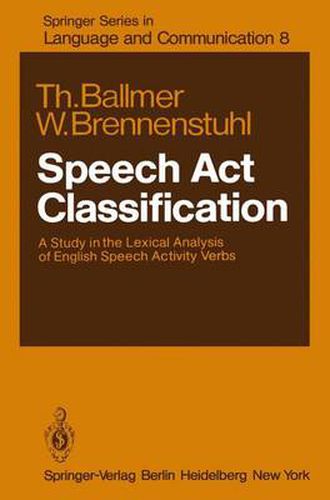Readings Newsletter
Become a Readings Member to make your shopping experience even easier.
Sign in or sign up for free!
You’re not far away from qualifying for FREE standard shipping within Australia
You’ve qualified for FREE standard shipping within Australia
The cart is loading…






This title is printed to order. This book may have been self-published. If so, we cannot guarantee the quality of the content. In the main most books will have gone through the editing process however some may not. We therefore suggest that you be aware of this before ordering this book. If in doubt check either the author or publisher’s details as we are unable to accept any returns unless they are faulty. Please contact us if you have any questions.
This book presents a new classification of speech acts. It is an alter native to all previously published classifications of speech acts. The classification proposed here is based on an extensive set of data, name lyon all the verbs designating linguistic activities and aspects thereof. A theoretically and methodologically justifiable method is used to proceed in a number of steps from these data to the classification. The classification is documented in a lexicon with two sections. The first section exhibits the classification in all its details. Each verb is listed to its meaning at the appropriate place in the classification. according The second, alphabetically ordered section enables one to locate the verbs classified in the first part. The speech act classification as presented in this book has a number of consequences for linguistic theorizing: the book makes advances in three linguistically relevant fields - speech act theory, lexicology, and theory of meaning. In speech act theory firstly of course a classifica tion is proposed which is theoretically justified and which is simul taneously based explicitly and systematically on linguistic data. Second ly, a wider concept of speech acts is introduced which proves its value by making possible a linguistically justified classification. Thirdly, the concept of speech act sequence (or more generally partial order) is brought into focus as a major organizational principle of the semantic relation between speech acts.
$9.00 standard shipping within Australia
FREE standard shipping within Australia for orders over $100.00
Express & International shipping calculated at checkout
This title is printed to order. This book may have been self-published. If so, we cannot guarantee the quality of the content. In the main most books will have gone through the editing process however some may not. We therefore suggest that you be aware of this before ordering this book. If in doubt check either the author or publisher’s details as we are unable to accept any returns unless they are faulty. Please contact us if you have any questions.
This book presents a new classification of speech acts. It is an alter native to all previously published classifications of speech acts. The classification proposed here is based on an extensive set of data, name lyon all the verbs designating linguistic activities and aspects thereof. A theoretically and methodologically justifiable method is used to proceed in a number of steps from these data to the classification. The classification is documented in a lexicon with two sections. The first section exhibits the classification in all its details. Each verb is listed to its meaning at the appropriate place in the classification. according The second, alphabetically ordered section enables one to locate the verbs classified in the first part. The speech act classification as presented in this book has a number of consequences for linguistic theorizing: the book makes advances in three linguistically relevant fields - speech act theory, lexicology, and theory of meaning. In speech act theory firstly of course a classifica tion is proposed which is theoretically justified and which is simul taneously based explicitly and systematically on linguistic data. Second ly, a wider concept of speech acts is introduced which proves its value by making possible a linguistically justified classification. Thirdly, the concept of speech act sequence (or more generally partial order) is brought into focus as a major organizational principle of the semantic relation between speech acts.